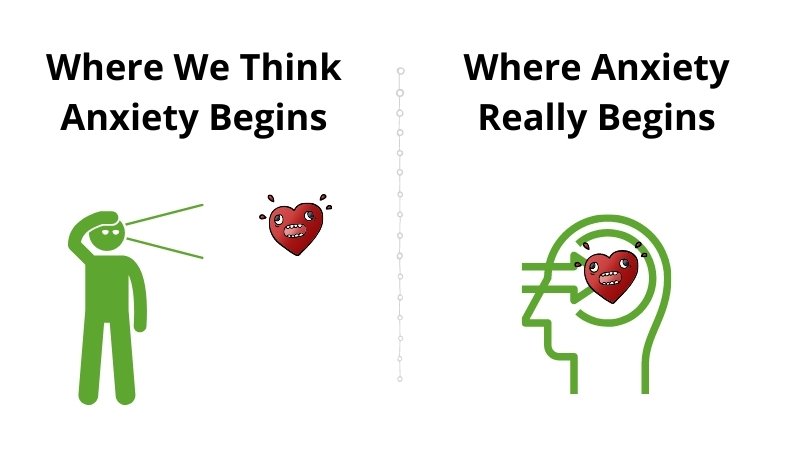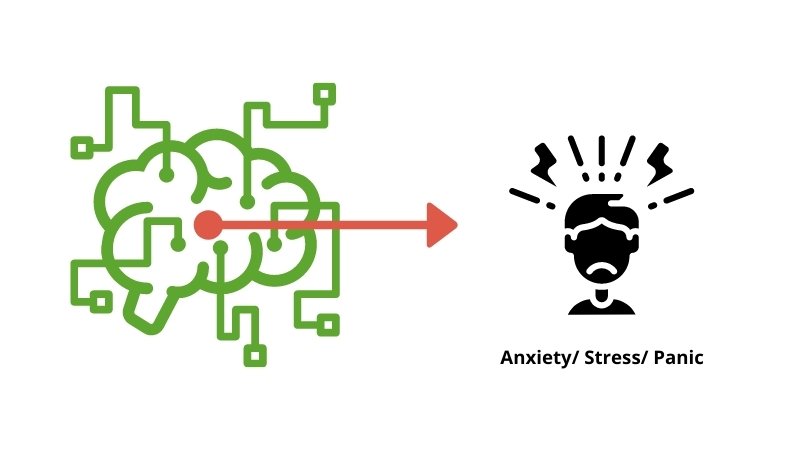Rewire Your Anxious Brain Summary teaches you how to condition your brain to produce less anxiety-ridden thoughts and how to make the most of your lives by avoiding unnecessary stress caused due to fears and anxieties.
Elizabeth M. Karle is a collection management supervisor at Cushwa Leighton Library.
Learn more about the author here.
Rewire Your Anxious Brain Summary (PDF)
Before I start this summary, I want to let you know that I’m no doctor or psychologist.
Whatever lessons I’m sharing here, I’ve learned from this book.
Anyway, there is nothing to worry about.
This summary is about understanding how our brain works and how to rewire it to reduce anxiety.
Alright, let’s dive right in.
Best Tools for Bibliophiles
- Listen to your Favorite Books on The Go: Try Audible and Get Up To 2 Free Audiobooks | Get 3 Free Audiobooks
- Read over 2 million e-books on any device: Sign up for 30 days free trial of Kindle Unlimited and read your favorite titles.
- Get free 2-day shipping of your favorite books and stream premium TV shows on Amazon Prime: Sign up for 30 days free trial of Amazon Prime.
- I use Notion to take reading notes, plan everything, and run all my businesses. (Notion is my Second Brain 🤯): Get Notion for free for personal use (paid for teams/businesses)
The Drawbacks of Anxiety And Why You Need To Cope With It
Anxiety can be troublesome, right?
It doesn’t matter what aspect of your life is; if there is anxiety, it can limit your growth.
It can stop you from doing things that grow your brain.
For example:
If English isn’t your first language, you might get anxious before giving a speech in front of an audience.
Sometimes, you don’t even know why you are anxious:
Your heart rate increases.
Your muscles feel tense.
You feel hopeless all of a sudden.
These all are the symptoms of anxiety.
Now imagine:
You are going to do an important task, and suddenly anxiety strikes you.
It’d be horrible, right?
The worst thing is:
When anxiety strikes, our brain feels helpless.
You don’t realize what is happening and why.
Not all people are psychologists. When anxiety strikes, they think that there is something wrong with them.
Anxiety and fear are like sisters.
When there is fear, there will likely be anxiety.
The question is:
How can one deal with it?
Or even better:
How can one avoid it in the first place?
Keep reading to learn.
Anxiety begins in your head based on how you interpret events
The first thing you need to learn about anxiety is:
It begins in our heads.

If you didn’t have that big brain in your head, you wouldn’t have any fear or anxiety to deal with.
Does this mean that external factors don’t have any effect?
The thing is:
How we interpret events predominantly affects how we think and feel.
Our experiences shape the structure of our brain. (More on that later)
For instance:
You would fear if a stranger is walking towards you with a cricket bat in his hand at night.
But does this mean that there is any danger?
The answer is:
No one knows. One can only assume in that case and take the best action.
It may happen that maybe the person was playing cricket and is returning to his home.
The stranger may also be a thief, and you are his target. Perhaps he was following you and is now going to strike.
Now:
It’ll depend on how you interpret that situation.
If you think positively in that situation, chances are you won’t be afraid.
And if you have a bad memory or episode in your life, negative thoughts will fill your head. The fear will grip you.
Again imagine:
If you didn’t have your brain, how would you react? You wouldn’t feel a thing.
The root of the anxiety is always in your head.
And how you interpret events and situations affects how you think and feel.
Now let’s get serious and learn what happens inside our brain that causes anxiety.
Cortex And Amygdala: The key areas in the brain that produce anxiety
The Cortex and Amygdala are two critical areas of your brain that produce anxiety.
To reduce anxiety, you must know how these two work.
What is Cortex?
Simply put, it’s a part of your brain that helps in logic and reasoning.
And what is Amygdala?
Simply put, it’s the defense mechanism in our body that activates when danger is detected.
The author has explained these two pretty nicely.
Most anxiety is either Amygdala-based or Cortex-based.
In the case of Amygdala-based anxiety, we experience physiological symptoms like increased heartbeat, muscle tension, etc.
And in the case of Cortex-based anxiety, our thoughts or interpretations of events worsen the anxiety by activating Amygdala.
So identifying the type of anxiety is crucial to cope with it.
If the anxiety is Amygdala based, logical reasoning would hardly work.
If the anxiety is Cortex-based, strategies that work with Amygdala-based anxiety won’t work effectively.
One thing worth noting down is:
Amygdala can overtake the control of the brain in a dangerous situation.
For instance:
If there is a wild animal in front of you, would you stand there and think or run?
Of course, you won’t want to write a book on wild animals then. You would escape from there and save your life.
The author says that when we face extreme danger, the Amygdala takes over and shuts any logic or reasoning. And our body acts without a thought.
The question is:
What if we get rid of the Cortex and Amygdala?
Again, it wouldn’t help.
These parts in our brain exist to protect ourselves from danger.
Our ancestors had to protect themselves from wild animals in ancient times. So these parts helped a lot back then.
Fortunately, our situation is way better now.
But still, knowing this doesn’t solve the problem.
You need to find a way to train your Cortex and Amygdala so that they work when they should work.
And they don’t interfere when they don’t need to.
Anxiety is neither good nor bad
Is anxiety good? No one would say that.
Is it bad? Of course. Everyone will agree.
But in reality:
It’s neither good. Nor bad.
The reason?
It exists to protect us from potential threats or dangers.
It has helped humans to avoid dangers and stay alive.
If you learn how to deal with anxiety, it can boost your potential.
Not all anxiety necessarily means danger
Anxiety can be troublesome.
But it doesn’t always indicate danger.
Our imagination can cause us to anticipate events or possibilities that don’t even exist.
For example:
If someone’s family member is not picking up the call, he might assume something is wrong.
But in reality:
The person doesn’t have enough data and is just making things up inside his head, which is then causing more anxiety.
The author talks about two anxiety pathways in this book.
One is the Amygdala pathway. And the other is Cortex Pathway.
Whenever your senses receive any information, a part of the brain (called the hypothalamus) sends sensory information to the Amygdala and Cortex.
In the Amygdala pathway, the information first goes to Amygdala directly, and if any danger is sensed, the Amygdala takes over, causing you to respond.
In the Cortex pathway, the information sensed goes to Cortex first. Then it depends on the reasoning or logic. If the reason concludes that danger exists, it activates the Amygdala.
Note that:
“Cortex itself doesn’t produce any anxiety. It needs other parts of the brain to do so.”
See now? This is why you feel more anxious when you have more negative thoughts inside your brain.
It doesn’t mean that negative thoughts shouldn’t exist.
Thoughts are just thoughts.
If you feel that your thoughts fully represent reality, it’s more likely to give you trouble.
In the same reality, two people can have entirely different thoughts.
That’s why people keep saying that you should change your mindset and look at problems as opportunities.
You train your brain not to take your thoughts seriously when you start doing that.
But again, remember:
The entire mechanism in the brain is there to protect you from threats.
Things have changed a lot these days. So those old mechanisms create problems instead of solving them.
Fortunately, you can train your brain.
Neuroplasticity: How to teach your brain to produce less anxiety?
Our brain is plastic in nature.
The author found that our brains can change their neuron structure with time.
As you gather more information or experience, your brain keeps reorganizing itself and becoming better.
It’s common knowledge:
The brain is the control center of our body.
To reduce your anxiety, you need some way to control the anxiety-producing areas in your brain.
And it’s only possible through training.
Later, we will discuss how to train your brain through various exercises like deep breathing.
Exercise and sleep can help in reducing anxiety through relaxation
First, let’s talk about how exercise can reduce anxiety and panic attacks.
Indeed, any exercise helps us relax our muscles.
So when you exercise often, your muscle tension reduces. This helps in the cases of Amygdala-based anxiety when there are physiological symptoms.
The author suggests that you do breathing exercises.
Deep breathing while being anxious helps you to reduce anxiety.
Another thing that people often miss is how vital deep sleep can be for their mental health.
When you don’t get a night of deep sleep, you feel tired and exhausted throughout your day.
Good sleep helps your brain to reset and reorganize.
It might seem like a simple thing.
But it has a considerable effect.
The more relaxed you are, the better you can deal with anxiety problems.
Certain thinking patterns worsen anxiety

Our ability to think is wonderful.
But when it goes out of control, it can cause panic.
Now, what you can do is:
You can write down your thoughts.
And try to understand which ones cause anxiety issues.
Then replace them with positive thoughts.
If possible:
Don’t overthink!
Try to understand logical fallacies and biases.
Remember:
Your thoughts don’t accurately represent reality.
Plus, our brain helps us imagine things that haven’t happened yet.
So there is no guarantee that the worst-case scenario you imagine before getting anxious will happen.
Just relax.
Try to figure out the source of anxiety first, as the author says.
If the anxiety is Amygdala based, take deep breaths and try to calm down.
And if the anxiety is Cortex-based, realize that your thoughts are just thoughts.
Try to observe the reality.
You can unlock your full potential in life after getting rid of anxiety
If you ignore your anxiety issues, you are limiting yourself from exploring the infinite possibilities.
What if you could do every single thing in your life without worrying too much about it?
What if you could get rid of your unwanted fears?
Simply, it’d be amazing, right?
But it’s also true that you would be prone to threats if you didn’t have your fear and worries.
It’s up to you how you deal with it.
If you are smart, you can deal with anxiety-ridden thoughts and achieve your goals.
Always remember:
Your brain is plastic.
Regardless of what your age is, it can learn and reshape.
I’d suggest that you read this book summary: What To Say When You Talk To Yourself.
What you say to yourself can also help you train your Cortex to produce less anxiety-creating thoughts and prevent it from unnecessarily activating your Amygdala.
My Personal Key Takeaways from Rewire Your Anxious Brain Summary
Here are my takeaways from this book:
- Anxiety begins in our brain.
- We can have wrong interpretations of reality.
- Our thoughts can act as a curse if taken too seriously.
- Our brain is neuroplastic. So it can change over time for good.
- Fears and anxiety are the alert-mechanism in our body. They protect us from potential threats.
- Deep breathing can help ease the physiological effects of anxiety.
- One needs to take a good sleep and do exercise to live a stress-free life.
- One needs to understand his brain’s key areas to handle mental problems.
Best Tools for Bibliophiles
- Listen to your Favorite Books on The Go: Try Audible and Get Up To 2 Free Audiobooks | Get 3 Free Audiobooks
- Read over 2 million e-books on any device: Sign up for 30 days free trial of Kindle Unlimited and read your favorite titles.
- Get free 2-day shipping of your favorite books and stream premium TV shows on Amazon Prime: Sign up for 30 days free trial of Amazon Prime.
- I use Notion to take reading notes, plan everything, and run all my businesses. (Notion is my Second Brain 🤯): Get Notion for free for personal use (paid for teams/businesses)
Rewire Your Anxious Brain Review
So now it’s time for the critical review of this book.
Things I didn’t like in this book
- Lots of technical jargons
- Repetition of the same things in every chapter (Fluffy)
- Not suited for people who don’t believe in science
- It might be boring for some people
- Solutions provided seem theoretical
Things I liked in this book
- Complicated topic made easy
- Practical examples
- It helps you understand how your brain works
- Many affirmations to help you rewire your brain
- Easy to understand
Some afterthoughts
This book is a handbook for dealing with anxiety problems.
But expect technical jargon to mess with your head a bit.
After all, our brain is a complex machine.
So take your time to understand the scientific terms like the central nucleus, neurons, etc.
Don’t expect to be anxiety-free right after reading this book.
This book can guide you, but only by applying the concepts you’ll learn if they work or not.
Merely understanding your brain is not enough.
You need to figure out the prime cause of your anxiety.
And then try to fix it.
Simultaneously, you have to train your brain to worry less and live more.
Buy this book from Amazon: Hardcover | Paperback | Audiobook
Who would I recommend Rewire Your Anxious Brain Summary?
I’d recommend this book summary to anyone who encounters anxiety often.
You need to read this if you get an anxiety attack out of the blue.
Why?
Because when you don’t understand why some weird thing is happening to you, you unnecessarily create more anxiety. (Remember?)
People researching the brain or a psychologist who has just started learning about psychology can also read this book (or book summary).
=>Check the latest price of this book on Amazon
Now it’s your turn
I learned a lot from this book.
And I hope you learned a lot from this book summary too.
Now, over to you:
Have you ever faced a panic attack? How does it feel? What strategies do you personally use to deal with anxiety-ridden thoughts?
Have you ever taken guidance from a psychologist?
Or do you know anything else that I didn’t mention in this summary and can be helpful to others?
Let me know in the comments below.
And as always, share this summary with your friends and family members.
Want to consume more insightful, power-packed content like this in the future?
Subscribe to the weekly email newsletter.
Subscribe to YouTube channel for animated video books.
Try Amazon’s Audible 30-days Free Trial and Get 2 Audiobooks for free.

